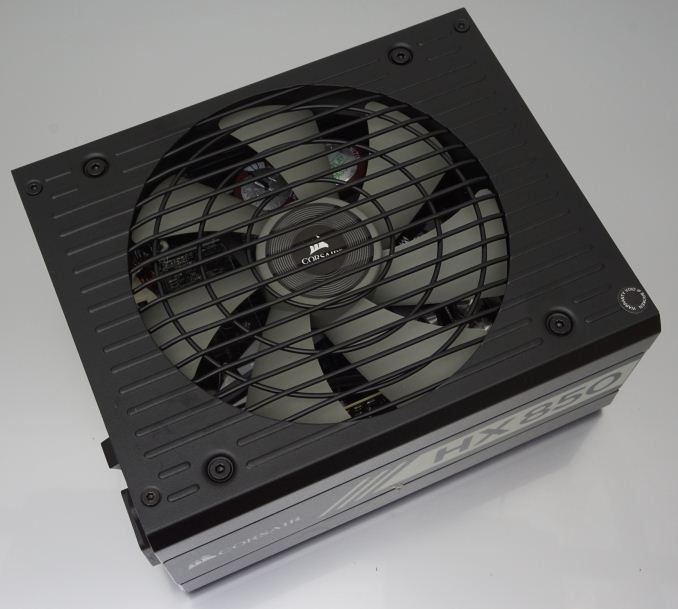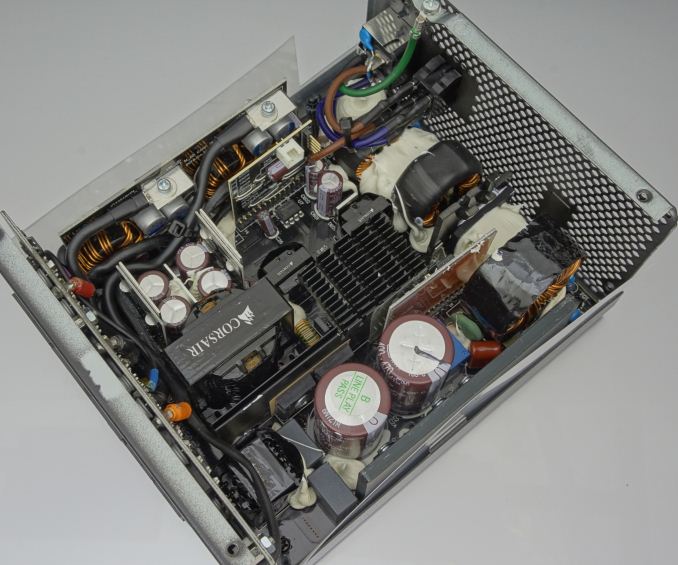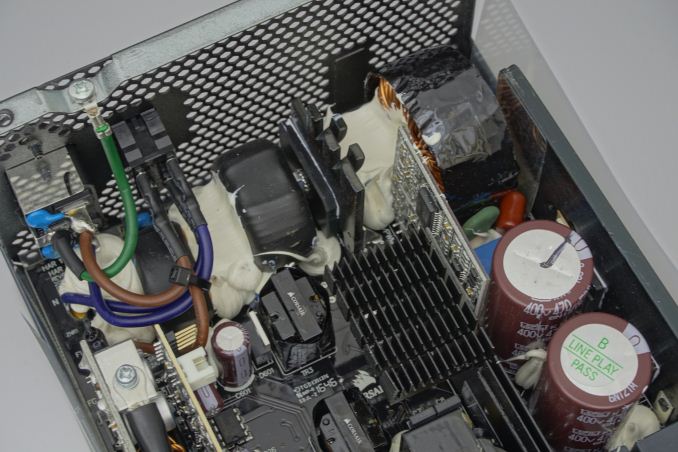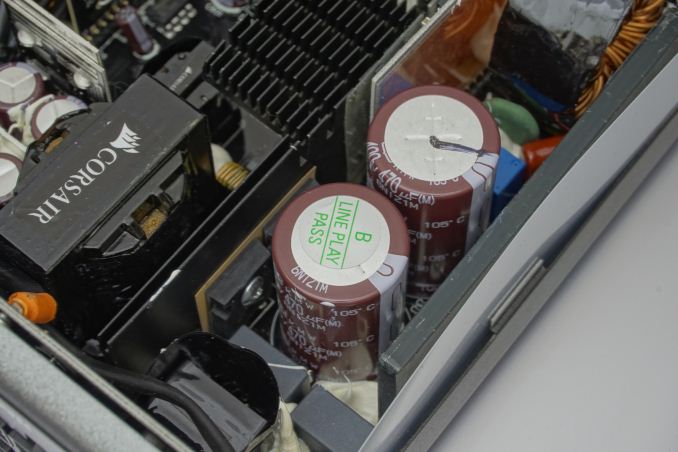The Corsair HX850 80Plus Platinum PSU Review
by E. Fylladitakis on October 24, 2017 8:00 AM EST
In this review we are having a look at the latest revision of Corsair’s HX PSU series. The main improvements of the new series revision are an improved certification to Platinum, a fully modular design, and now an extended 10-year warranty. We are testing the HX850 model, suitable for 850W which can easily feed a powerful dual GPU gaming/workstation system.
Recent Power Supply Reviews
AnandTech tests a good number of power supplies each year, mostly in the popular power ranges (650-850W) with a few reviews now-and-again for small form factor parts or larger behemoths. Here are the power supplies we have reviewed in the last twelve to eighteen months.
- [link] The Corsair HX850 80Plus Platinum PSU Review (this review)
- [link] The Enermax Revolution SFX 650W PSU Review
- [link] The Seasonic PRIME Titanium PSU (650W, 750W, 850W) Review
- [link] The Riotoro Onyx Power Supply Review: 650W & 750W Tested
- [link] The BitFenix Whisper M 450W & 850W PSU Review
- [link] The Silverstone ST30SF & ST45SF SFX Power Supply Review
- [link] The Zalman ZM1200-EBT 1200W Power Supply Review
- [link] The SilverStone SX700-LPT SFX 700W PSU Review
The Corsair HX850: Introduction
Corsair released their first computer power supply units (PSUs) well over a decade ago. The first two units, the HX520W and the HX620W, first hit the store shelves back in 2006. The company has come a long way since then, as today they are one of the most reputable PSU manufacturers, marketing dozens of units through seven different product series. They also are one of the most influential companies, frequently introducing new platforms, upgrades, and innovative technologies.
Each of Corsair’s seven PSU series has been developed with a specific market group in mind. The company is constantly upgrading/adapting the products of each series with new revisions, but the specific market group for that series always remains unchanged. For example, their first series, the HX, was developed to target the demanding high-end market. The original HX520W and the HX620W are now but a distant memory, yet the HX series is still targeted towards demanding PC enthusiasts, consisting of eight high output (750-1200 Watt) units with very impressive specifications.
In this review we are having a look at the latest revision of the HX series, the HX850 (CP-9020138). This is the third revision of the 850-Watt HX unit, which was initially released with the first revision back in 2009. The most apparent upgrades of this latest revision are 80Plus Platinum efficiency levels and a fully modular design, plus an improved (10 year) manufacturer’s warranty.
| Corsair HX850 (Rev 3) Power Specifications ( Rated @ 50 °C ) |
|||||
| AC INPUT | 100 - 240 VAC, 50 - 60 Hz | ||||
| RAIL | +3.3V | +5V | +12V | +5Vsb | -12V |
| MAX OUTPUT | 25A | 25A | 70.8A | 3A | 0.8A |
| 150W | 850W | 15W | 9.6W | ||
| TOTAL | 850W | ||||
Internal Inspection
The 135 mm fan responsible for the cooling needs of the HX850 is the Corsair NR135P, a fan we frequently see in the company’s high-performance PSUs. Unfortunately, we cannot identify the OEM of the fan but we can tell that it is a quality model with a fluid dynamic bearing engine for longevity. It has a maximum speed of about 1500 RPM but, considering the unit’s output and efficiency, it is highly unlikely that it will be reaching this speed under normal operating conditions. The HX850 features full range fan control with a passive mode, meaning that the PSU’s thermal circuitry will not even start the fan unless airflow becomes necessary.
The OEM behind the latest version of the HX850 is Channel Well Technologies (CWT) design, a company that Corsair frequently trusts for their middle and high range products. They have been the OEM behind nearly all the HX series units to this date, with the exception of a few Seasonic designs many years ago. It is an upgrade of the version that the previous HX and RM units were using a few years back. This core design is currently being used for most HX and RM series PSUs, with small variations between the models.
The heatsinks of the HX850 are relatively small, even for an 80 Plus Platinum certified power supply. This is especially true for the secondary side of the PSU, where the heatsinks are small metallic braces with a volume of just a few cubic centimeters. A large portion of the heat dissipation on the secondary side is taking place underneath the PCB, towards the steel body of the unit. The APFC heatsink is thick but plain - essentially just a metallic slab with relatively little dissipation surface. Only the heatsink for the primary inversion circuit stands out, extending to form a small array of fins to increase its dissipation surface. Corsair is apparently placing a lot of faith in the efficiency of their latest design.
The filtering stage of the HX850 is typical for high output PSUs, with four Y capacitors, two X capacitors, and two filtering inductors. It has two conversion bridges with a small heatsink sandwiched in between them. The passive components of the APFC stage are two 400V / 470μF capacitors supplied by Nippon Chemi-Con and a very large filtering inductor that is partially wrapped into insulation material. The insulation material is probably not used mainly for protection but to prevent electromechanical vibrations that would result in noise (also known as “coil whine”). CWT extends this practice to nearly all the filtering inductors found inside their premium designs.
Two MOSFETs form an LLC resonant half-bridge inversion stage, whereas a horde of eight MOSFETs on the secondary side generates the 12V line of the unit. The 3.3V and 5V lines are derived via DC to DC conversion circuits found on the horizontal daughterboard at the edge of the PSU. All of the electrolytic capacitors are supplied by Nippon Chemi-Con, as are nearly all of the polymer capacitors as well. A couple of the polymer capacitors are supplied by Nichicon, ensuring that only capacitors from Japanese companies can be found in the HX850.



















26 Comments
View All Comments
DanNeely - Tuesday, October 24, 2017 - link
I think I found an error. The table lists only 1 4+4 pin CPU power cable. Corsair lists 2 (as does newegg). In addition there're 5 12v connector ports on the PSU, 2 CPU and 3 GPU cables would fill this out nicely. And with the proliferation of new high end boards expecting 8+4 or 8+8 CPU power connections only 1 would be a poor fit for the enthusiast market.http://www.corsair.com/en-us/hx-series-hx850-850-w...
DanNeely - Tuesday, October 24, 2017 - link
I also have a question. Do the PCIe cables split into a Y with 2 independent wire bundles at the PSU or are the two connectors daisy chained on a single wire bundle.I'm asking because with the proliferation of single 8 pin power connection GPUs the daisy chain topology makes cable management a lot easier since you don't have to hide an entire 18 or 24" wire bundle. Having to do so sorta defeats the purpose of modular design IMO.
jonnyGURU - Monday, October 30, 2017 - link
All of the Corsair PSUs that use Type 3 or Type 4 cables use "pig tail" cables that put two PCIe connectors on one cable.TEAMSWITCHER - Tuesday, October 24, 2017 - link
That 10 year warranty is a nice feature.Golgatha777 - Tuesday, October 24, 2017 - link
Hopefully you'll never need it. My HX850 has been going strong through multi-gpu and overclocked CPU setups since Sept 2011. Currently it's got a light load of an overclocked i7-5820k and GTX 1080 ti.DanNeely - Tuesday, October 24, 2017 - link
Good PSUs tend to be rather reliable so probably not. Over the last 15 years I've gotten about 35-40 years or so of run time over 7 or 8 different PSUs in my personal computers. 0 failures with anything electrical. 1 mechanical fault from a modular connector plug that somehow got smashed back into the body of the PSU and no longer made good electrical contact with the cable plugged into it.Attrition in models over the years has been mostly due to changing standards. 3.3/5v vs 12v focused models. Sata plugs instead of molex. The CPU connector going from 4 pins to 8 pins (and to twin connectors whenever I build a new high end box). PCIe power plugs being added, increasing in number and getting 8 pin versions. At the bottom end I think I retired a basic 80+ model after working out that over the boxes lifespan a more efficient one would pay for itself.
just4U - Wednesday, October 25, 2017 - link
G..Your's was made by Seasonic, CWT has never been quite as good. The warranty is nice though.
jonnyGURU - Monday, October 30, 2017 - link
They leap frog each other. Seasonic stalled for a while, allowing CWT to put out better products for a number of partners. But with the Prime line, Seasonic has jumped back ahead. Still... I'd take a newer CWT over an older Seasonic.StevoLincolnite - Wednesday, October 25, 2017 - link
Got an almost 12 year old HX620 humming along fine in a Core 2 Quad QX9770 @ 3.8ghz + 8GB DDR2 + Radeon 7970 rig. Still plays the latest games at 1080P every day.Only PSU's I will buy are Corsair... Another company would need to prove they have the reliability+features+warranty and beat Corsair on price for me to even remotely consider them.
BurntMyBacon - Wednesday, October 25, 2017 - link
@StevoLincolniteCorsair (HX or AX series only) is one of only three PSU manufacturers I consider for builds as well. I have seen good reliability out of them with their HX and AX series supplies. Judging by your criteria, I propose considering Seasonic for your short list as well. I've installed several of their old X-Series power supplies that are about the same age as your H620 and still going strong. Two of them are 24-7 operators (Folding@home or gaming) with multiple GPUs. The irony is Corsair used Seasonic's platform for a lot of their earlier HX and AX series PSUs so your HX620 may in fact be a Seasonic platform. Their prime series has some of the best performance in the industry (Similar to Corsairs Flextronics based AX1200/AX1500) and they come with a 12 year warranty. About the only thing missing (for those who can use it) is a Corsair Link equivalent. Pricing is competitive with Corsairs HX and AX series supplies and the better deal usually comes down to which one is on sale.
Warranty Upgrade:
https://seasonic.com/seasonic-upgrades-prime-serie...
Article to check it out:
https://www.hardocp.com/article/2016/07/21/seasoni...